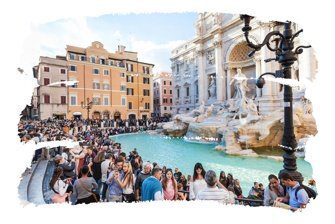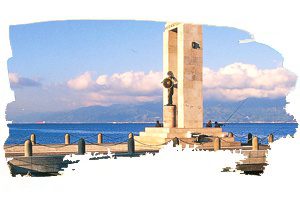What are the 30 most used phrases during a trip in Italy?
Oh Italy! So, you are finally there, in full tranquility, happy and… You’re thirsty! Do you know how to ask for water to the waiter without playing “guessing game involving mime”? Well, today we will teach you the 30 most used phrases in Italy! Italian is not a difficult language, but it can mess with the head of those who are not used to the language. Being a Latin language, it has a structure that, once understood, flows easily. Today we will know what are the 30 most used phrases during a trip in Italy. Here at Your Travel to Italy with Ana Patricia you make the trip of your dreams!!! ALSO: see our “Accommodation in Italy – Tips for your holidays!”
Good to know…
If there is one thing that conquers any Italian, it is a well given “good morning”! Trust me: the famous “buon giorno” accompanied by a smile can change your experience in a scandalous way! Italians value education in a visible way and they will hardly close their faces if you offer them a smile followed by a lovely word, but what are these words? Sentences? Yep! Below we list the 30 most used (and useful!) phrases for tourists in Italy! Shall we know them? Let’s go!
About this post…
this post is not intended to teach Italian (pronouns, articles, grammatical structure, etc.). This post aims to offer the traveler a base of the most used phrases and, for that, it is necessary to have a minimum knowledge of the pronunciation of letters, diphthongs etc. If you want, feel free to contact me so that I can send you the contact of an professional Italian teacher that will be able to help you learning a little bit of Italy before your travel.
About Phonetics
First things first… Let’s learn how to pronounce the alphabet in Italian:
- A – Pronounced, always, like the A in the word ‘bar: albero (tree)
- B – It has the same sound as in English: banana (banana)
- C – so, if followed by an ‘e’ or an ‘i’, ‘c’ will be pronounced like the ‘ch’ in ‘cheese’, although, If followed by an ‘h’, it will change the sound for ‘c’ in ‘cut’: cioccolato (chocolate); cane (dog)
- D – The same pronouncing as in English: dadi (dice).
- E – It can be tricky, but it’s easy! So, it can be open (like in ‘net’) or closed (like in ‘them’), depending on its location in the word, the sound change. It can also vary, depending on the regional accent of the speaker, but, NOPE! You don’t have to worry about it: we will understand what you’re saying! Example: elefante (elephant)
- F – The same pronouncing as in English: fiore (flower).
- G – Here we go: so, if the G is followed by an ‘i’, then you will need to pronounce like the ‘j’ in ‘jumble’; if followed by an ‘n’, together, it will sound like the Spanish ‘ñ’ (we know that there’s no English equivalent, but it’s not hard to pronounce, a tip: you can think of the ‘ny’ sound in the word ‘onion’). Last, but not least, if the G is followed by any other letter, it’s pronounced the same as in ‘go’. Example: gatto (cat).
- H – The letter is only used to define the pronunciation of ‘c’, or silently in combination with ‘g’. Confusing? See an example: hotel (hotel).
- I – Always, always, always pronounced like the ‘ee’ in ‘see’: imbuto (funnel)
- J – The same pronouncing as in English: Julio (Julio) NOTE: is a rare case in Italian, there is not a lot of words that use J, but it can also sound like the word ‘you’: as in Juventus, in Italian we say ‘youventus’.
- K – Also the same pronouncing as in English: Kevin (Kevin)
- L – Once again: the same pronouncing as in English. Libertà (freedom), leone (lion).
- M – Also the same pronouncing as in English: mela (apple)
- N – Exactly the same pronouncing as in English, except when used in the ‘gn’ combination (we will see it later): nave (ship)
- O – As in the ‘o’ in ‘horse’: orologio (clock)
- P – The same pronouncing as in English: pera (pear)
- Q – The Q is always pronounced like the ‘k’ in the English word ‘make’: quadro (painting)
- R – The ‘r’ is slightly rolled. How? Well, the top of the tongue casually touches the roof of the mouth: ruota (wheel).
- S – The same pronouncing as in English: sole (sun).
- T – Also the same pronouncing as in English: tavolo (table).
- U – The same as in English; it sounds like the ‘oo’ in ‘boo’: uva (grape)
- V – The same pronouncing as in English: vaso (vase/jar).
- W – The same pronouncing as in English: whisky (whisky)
- X – The same pronouncing as in English: xerofagia (xerophagy).
- Y – It also had the same pronouncing as in English: yatch (yatch)
- Z – The terror of a lot of people, but so easy to pronounce. So, the Z is always pronounced like the ‘ts’ in the English word ‘mats’: zebra (zebra) – NOTE: also the double Z we pronounce as ‘ts’, but ‘stronger’, ok?!
Let’s go harder…
Italian is an amazing language and its pronunciation, as we saw, is very easy. Most words are pronounced exactly like they are spelled, so you won’t have major problems speaking Italian. Important to know is that there are only seven pure vowels, but Italian language has A LOT of diphthongs and triphthongs. In English the vowels tend to be diphthongized, with an extra yuh or wuh after the actual vowel, you know that, right?! So, in Italian, make sure to say ONLY the pure vowel and not the diphthong, ok?!
Check bellow what i am talking about
Italian Vowels – English Pronunciation
- [i] vita ee as in meet
- [e] vedi ay as in bait
- [ɛ] era eh as in bet
- [a] cane ah as in father
- [u] uva oo as in boot
- [o] sole oh as in boat
- [ɔ] modo aw as in law
Semi-Vowels
- [w] quando, uomo: wuh as in won
- [j] piano, ieri, piove: yuh as in yes
Considerations
The GN – So, you will find A LOT of words with the GN letters! A LOT! To pronounce ‘gn’ in Italian, you have to start with the middle of your tongue placed right behind your top two front teeth; as you release the sound, move your tongue back, away from your teeth and to your throat:
- Gnocchi
- Agnello (lamb)
- Bagno (bagno)
The GLI – Gli is a masculine article, but you will also find this letter combination within other words. Although, pay attention: it is NOT pronounced how it looks; it is pronounced like the ‘lli’ in the English word ‘million’.
- Figlio – son
- Negli – in the
- Dagli – from the
- Maglietta – sweater
The SCE/SCI – This next one is not hard to pronounce, but it takes a little time to get used to it! So, when followed by an ‘e’ or an ‘i’, ‘sc’ is pronounced in the same way we pronounce ‘sh’ in English.
- Conoscere – to know
- Scena – scene
- Pesce – fish
Tip
- PRACTICE! A lot! Listen Italian music, read some italian articles out loud, what movies and pay attetion to how Italian sounds! Make you brain used to the Italian, it helps a lot!
Some Phrases
So, knowing how to read and pronounce the letters in the right way, it’s much easier to speak and to understand Italian language! Italy without any more worries! Let’s go to the sentences? It’s worth remembering that they don’t follow an “order”, the list is just a reference.
- Ciao, mi chiamo X, sono da…. Piacere. – Hi! My name is… – I am from… – Nice to meet you!
- Vorrei un biglietto di ritorno per X. Quanto viene? – Gostaria de uma passagem ida e volta para X. Quando custa?
- Vorrei un biglietto di ritorno per X. Quanto viene? – I would like a round-trip ticket for X. How much is it?
- Vorrei un piatto di X e da bere un (a) X per favore (or per piacere). – I would you like to eat X and to drink X, please.
- Quanto ti devo? Accettate carte di credito? – How much is it? Do you accept credit card?
- Buonasera (buon giorno), ho una camera prenotata. Ecco i miei documenti. I have a reservation. Here are my documents!
- Buona sera! (Buon giorno!) A che ora è la prima colazione? Grazie. – Good evening! (Good morning!) What time is breakfast? Thank you!
- Scusa, il mio bagaglio non è arrivato ancora! Cosa devo fare? – Excuse me, my luggage hasn’t arrived yet! What should I do?
- Potrei vedere il menu? – May I see the menu?
- Può portarmi un altro/a cuscino/asciugamano/coperta? – Could you bring me an extra pillow / towel / blanket?
- Una bottiglia d’acqua non gassata (gassata), per favore! – A bottle of still water (sparkling), please!
- Parto domani! – I’m leaving tomorrow!
- C’è la conessione internet qui? La posso usare? – Do you have an internet connection here? How much can I use? – How much is it?
- Dov’è il bagno? – Where is the bathroom?
- Una spremuta d’arancio, per favore! – A natural orange juice, please. TIP: If you want a juice bottle, ask for a ‘juice’.
- Scusi, dovè il/la X: Come arrivo a X? – Excuse me, where is the…: how do I go to X?
- Non parlo italiano molto bene, puoi parlare piano, per favore? Parla inglese? – I don’t speak Italian very well, can you speak slowly, please? Do you speak English?
- Dove prendo il treno per andare a X? – Where do I take the train to go to X?
- A che ora chiudete il negozio? – What time do you close?
- Dov’è l’uscita? – Where is the exit?
- Puoi scrivere, per favore? – Can you write, please?
- Il resto é per lei! – You can keep the change!
- Posso scattare una foto? – Can I take a picture?
- Parla inglese? – Do you speak English?
- Mi consigli un buon ristorante nei dintorni? – Can you recommend a restaurant nearby?
- In quale direzione? – Which direction?
- Puoi aiutarmi, per favore? – Can you help me please?
- Va bene! Ti ringrazio per la gentilezza! – OK! Thank you for your kindness!
- E’ stato un piacere conoscerti, grazie di tutto! – It was a pleasure to meet you, thanks for everything!
- Non ho capito! – I didn’t understand!
- Mi puoi dare la chiave per la camera X, per piacere? Grazie! – Can you give me the key to room number X, please? Thank you!
Some basic and useful words!
- Hi! Hello! Hey! – Ciao!
- Good morning! – Buon giorno!
- Good evening!/Good night! – Buona sera! (when you arrive) / Buona notte! (when you leave)
- How are you? – Come va?
- Yes – Si
- No – No
- Please – Per favore
- Here it is! – Ecco qui!
- Thank you! – Grazie.
- Thank you very much! – Grazie mille.
- You’re welcome! – Prego
- I’m sorry! – Mi dispiace.
- Excuse me… – Mi scusi/con permesso.
- It was nothing! – Niente.
- No problems! – Nessun problema.(neanche um problema)
- Watch out! – Attenzione!
- Right – destra
- Left – sinistra
- In front, ahead – Avanti
- Back, turn back (in the sense of returning) – indietro
- Turn to… – svolti a…
Our Bonus
Know the main cities names in English AND in Italian:
- Milan – Milano
- Rome – Roma
- Florence – Firenze
- Venice – Venezia
Some signs and notices
- Entrata – entry
- Uscita – exit
- Ascensore – elevator
- È vietato – limited access
- Attenzione – Watch out!
- Tiri, tirare – pull
- Spinga, spingere – push
Conclusion
What are the 30 most used phrases during a trip in Italy? Italian is a fascinating language and, contrary to what many people think, it is not as difficult as it seems! Arrivederci! (See you soon!) And if you feel insecure, have no time, and need help to organize your trip, don’t hesitate to contact me! I will love to help you make your dream trip to Italy come true. And how can I do that? Keep reading this post until the end and you will understand how we make your life and your trip much easier
Did my post help you? If so, be sure to post your comment below, but if you still have questions just send me a message I will answer you as soon as possible!
An Extra Help for your Trip
The best content from Your Travel to Italy!
Learn more about our tours in Italy right now!
- What to visit in Italy in 10 days?
- The ten must-see places in Tuscany?
- The best tips to save on your trip to Italy?
- What are the 10 most visited cities in southern Italy?
- Airports in Italy? How to get to your hotel? (Venice, Milan, Rome, Florence)
- What to do in 1/2/3/4 days in the main Italian cities?
- The best tips on food in Italy (wines, typical food, enogastronomy tours)
- How to get from Fiumicino Airport to Rome downtown?
- Your Travel to Italy: 10 tips for traveling through Italy!
Best regards from Italy






 Save money!
Save money!